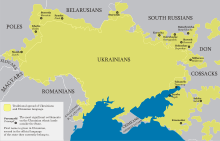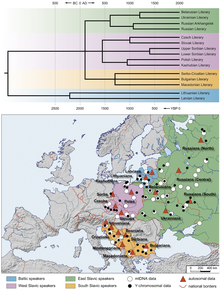Harshan Ukraniya
| Harshan Ukraniya | |
|---|---|
| українська мова | |
'Yan asalin magana |
harshen asali: 26,900,000 (2023) harshen asali: 27,300,000 (2019) 34,710,100 (2003) |
| |
|
Cyrillic script (en) | |
| Lamban rijistar harshe | |
| ISO 639-1 |
uk |
| ISO 639-2 |
ukr |
| ISO 639-3 |
ukr |
| Glottolog |
ukra1253[1] |
 | |



Yaren mutanen Ukraine, [ʊkrɐˈjinjsjkɐ ˈmɔʋɐ]). yare ne na Gabashin Slavic na dangin yaren Indo-Turai da ake magana da farko a Ukraine. Harshen asali yawancin Ukrainians ne.
Rubutun Ukrainian yana amfani da haruffa na Ukrainian, bambancin Rubutun Cyrillic. Kwalejin Kimiyya ta ƙasa ta Ukraine, (NANU; musamman ta Cibiyar Harshen Ukrainian). da Cibiyar Nazarin Harshe ta Potebnia suna nazarin harshen Ukrainian. [2] [3] yawa ana kwatanta su da Rasha, wani yaren Slavic na Gabas, amma akwai ƙarin fahimtar juna tare da Belarusian.[4][5]
Ukrainian ya fito ne daga Tsohon Gabashin Slavic, yaren da ake magana a cikin jihar Kievan Rus' ta zamani. A cikin Grand Duchy na Lithuania, yaren ya ci gaba zuwa Ruthenian, inda ya zama harshen hukuma, kafin a fara aiwatar da Polonization a cikin Polish-Lithuanian Commonwealth. [6][7] karni na 18, Ruthenian ya rabu zuwa bambance-bambance na yanki, kuma yaren Ukrainian na zamani ya bunkasa a yankin Ukraine ta yanzu. Rushewa ta ga an haramta yaren Ukrainian a matsayin batun daga makarantu kuma a matsayin harshen koyarwa a Daular Rasha, kuma ya ci gaba a hanyoyi daban-daban a Tarayyar Soviet. haka, yaren ya ci gaba da ganin amfani a duk faɗin ƙasar, kuma ya kasance mai ƙarfi ,musamman a Yammacin Ukraine.
Ci gaban harshe
[gyara sashe | gyara masomin]
Ka'idoji
[gyara sashe | gyara masomin]Ahatanhel Krymsky da Aleksey Shakhmatov sun ɗauka cewa akwai yaren da ake magana da shi na Slavs na Gabas ne kawai a zamanin da ba a san su ba. Bisa ga ra'ayinsu, bambancin harshen Tsohon Gabashin Slavic ya faru ne a karni na 8 ko farkon karni na 9.
7Masanin harshe na Rasha Andrey Zaliznyak ya bayyana cewa tsohuwar yaren Novgorod ya bambanta sosai da na sauran yaren Kievan Rus' a cikin karni na 11 zuwa 12, amma ya fara zama kamar su a cikin ƙarni na 13 zuwa 15. Harshen Rasha zamani ya samo asali ne daga haɗuwa da wannan yaren Novgorod da yaren yau da kullun da sauran Kievan Rus ke magana, yayin da yarukan Ukrainian da Belarusian na zamani suka samo asali ne game da yarukan da ba su bambanta da juna ba.
Ukrainian linguist Stepan Smal-Stotsky denies the existence of a common Old East Slavic language at any time in the past. Similar points of view were shared by Yevhen Tymchenko, Vsevolod Hantsov, Olena Kurylo, Ivan Ohienko and others. According to this theory, the dialects of East Slavic tribes evolved gradually from the common Proto-Slavic language without any intermediate stages during the 6th through 9th centuries. The Ukrainian language was formed by convergence of tribal dialects, mostly due to an intensive migration of the population within the territory of today's Ukraine in later historical periods. This point of view was also supported by George Shevelov's phonological studies, which argue that specific featuresSamfuri:Which were already recognizable in the southern dialects of Old East Slavic (seen as ancestors to Ukrainian) as far back as these varieties can be documented.
Manazarta
[gyara sashe | gyara masomin]- ↑ Hammarström, Harald; Forkel, Robert; Haspelmath, Martin, eds. (2017). "Harshan Ukraniya". Glottolog 3.0. Jena, Germany: Max Planck Institute for the Science of Human History.
- ↑ Alexander M. Schenker.
- ↑ Alexander M. Schenker.
- ↑ Alexander M. Schenker. 1993. "Proto-Slavonic", The Slavonic Languages. (Routledge). pp. 60–121. p. 60: "[The] distinction between dialect and language being blurred, there can be no unanimity on this issue in all instances..." C.F. Voegelin and F.M. Voegelin. 1977. Classification and Index of the World's Languages (Elsevier). p. 311, "In terms of immediate mutual intelligibility, the East Slavic zone is a single language." Bernard Comrie. 1981. The Languages of the Soviet Union (Cambridge). pp. 145–146: "The three East Slavonic languages are very close to one another, with very high rates of mutual intelligibility...The separation of Russian, Ukrainian, and Belorussian as distinct languages is relatively recent...Many Ukrainians in fact speak a mixture of Ukrainian and Russian, finding it difficult to keep the two languages apart..." The Swedish linguist Alfred Jensen wrote in 1916 that the difference between the Russian and Ukrainian languages was significant and that it could be compared to the difference between Swedish and Danish. Jensen, Alfred. Slaverna och världskriget. Reseminnen och intryck från Karpaterna till Balkan 1915–16.. Albert Bonniers förlag, Stockholm, 1916, p. 145.
- ↑ Alexander M. Schenker. 1993. "Proto-Slavonic", The Slavonic Languages. (Routledge). pp. 60–121. p. 60: "[The] distinction between dialect and language being blurred, there can be no unanimity on this issue in all instances..." C.F. Voegelin and F.M. Voegelin. 1977. Classification and Index of the World's Languages (Elsevier). p. 311, "In terms of immediate mutual intelligibility, the East Slavic zone is a single language." Bernard Comrie. 1981. The Languages of the Soviet Union (Cambridge). pp. 145–146: "The three East Slavonic languages are very close to one another, with very high rates of mutual intelligibility...The separation of Russian, Ukrainian, and Belorussian as distinct languages is relatively recent...Many Ukrainians in fact speak a mixture of Ukrainian and Russian, finding it difficult to keep the two languages apart..."
- ↑ Empty citation (help)
- ↑ Empty citation (help)
